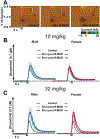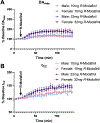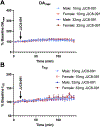An FSCV Study on the Effects of Targeted Typical and Atypical DAT Inhibition on Dopamine Dynamics in the Nucleus Accumbens Shell of Male and Female Mice
- PMID: 37466616
- PMCID: PMC10766117
- DOI: 10.1021/acschemneuro.3c00354
An FSCV Study on the Effects of Targeted Typical and Atypical DAT Inhibition on Dopamine Dynamics in the Nucleus Accumbens Shell of Male and Female Mice
Abstract
Understanding the neurochemistry underlying sex differences in psychostimulant use disorders (PSUD) is essential for developing related therapeutics. Many psychostimulants, like cocaine, inhibit the dopamine transporter (DAT), which is largely thought to account for actions related to their misuse and dependence. Cocaine-like, typical DAT inhibitors preferentially bind DAT in an outward-facing conformation, while atypical DAT inhibitors, like modafinil, prefer a more inward-facing DAT conformation. Modafinil and R-modafinil have emerged as potential therapeutic options for selected populations of individuals affected by PSUD. In addition, analogs of modafinil (JJC8-088 and JJC8-091) with different pharmacological profiles have been explored as potential PSUD medications in preclinical models. In this work, we employ fast scan cyclic voltammetry (FSCV) to probe nucleus accumbens shell (NAS) dopamine (DA) dynamics in C57BL/6 male and female mice. We find that cocaine slowed DA clearance in both male and female mice but produced more robust increases in evoked NAS DA in female mice. R-Modafinil produced mild increases in evoked NAS DA and slowed DA clearance across the sexes. The modafinil analog JJC8-088, a typical DAT inhibitor, produced increases in evoked NAS DA in female and male mice. Finally, JJC8-091, an atypical DAT inhibitor, produced limited increases in evoked NAS DA and slowed DA clearance in both sexes. In this work we begin to tease out how sex differences may alter the effects of DAT targeting and highlight how this may help focus research toward effective treatment options for PSUD.
Keywords: Dopamine; FSCV; dopamine transporter; modafinil; sex differences; substance use disorder.
Conflict of interest statement
Conflict of Interest
The authors declare no competing financial interest.
Figures








References
-
- UNODC, World Drug Report 2022. United Nations publication: 2022.
-
- Giros B; Jaber M; Jones SR; Wightman RM; Caron MG, Hyperlocomotion and indifference to cocaine and amphetamine in mice lacking the dopamine transporter. Nature 1996, 379 (6566), 606–612. - PubMed
Publication types
MeSH terms
Substances
Grants and funding
LinkOut - more resources
Full Text Sources

